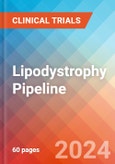Lipodystrophy Understanding
Lipodystrophy: Overview
Lipodystrophy refers to medical problem where there is an abnormal distribution of fat in the body. The disease may be inherited genetically, (for example, familial partial lipodystrophy or FPLD), or acquired. If inherited it may be present at birth (congenital). There are five types of lipodystrophy: Congenital generalized lipodystrophy, acquired generalized lipodystrophy, Acquired partial lipodystrophy, High active antiretroviral therapy-induced lipodystrophy, and Localized lipodystrophy. The specific symptoms present, severity, and prognosis can vary greatly depending upon the specific type of lipodystrophy and the presence and extent of associated symptoms. To make the medical diagnosis of lipodystrophy the doctor first examine the abnormal appearance caused by changes in fat loss or gain, and then he or she generally look for the characteristic clinical symptoms and signs.'Lipodystrophy - Pipeline Insight, 2025' report outlays comprehensive insights of present scenario and growth prospects across the indication. A detailed picture of the Lipodystrophy pipeline landscape is provided which includes the disease overview and Lipodystrophy treatment guidelines. The assessment part of the report embraces, in depth Lipodystrophy commercial assessment and clinical assessment of the pipeline products under development. In the report, detailed description of the drug is given which includes mechanism of action of the drug, clinical studies, NDA approvals (if any), and product development activities comprising the technology, Lipodystrophy collaborations, licensing, mergers and acquisition, funding, designations and other product related details.
Report Highlights
The companies and academics are working to assess challenges and seek opportunities that could influence Lipodystrophy R&D. The therapies under development are focused on novel approaches to treat/improve Lipodystrophy.Lipodystrophy Emerging Drugs Chapters
This segment of the Lipodystrophy report encloses its detailed analysis of various drugs in different stages of clinical development, including phase II, I, preclinical and Discovery. It also helps to understand clinical trial details, expressive pharmacological action, agreements and collaborations, and the latest news and press releases.Lipodystrophy Emerging Drugs
REGN4461: Regeneron Pharmaceuticals
REGN4461 is a leptin receptor (LEPR) agonist for lipodystrophy and obesity which is being developed by Regeneron Pharmaceuticals. It is currently in the Phase II stage of development. It is administered intravenously or subcutaneously.Lipodystrophy: Therapeutic Assessment
This segment of the report provides insights about the different Lipodystrophy drugs segregated based on following parameters that define the scope of the report, such as:Major Players in Lipodystrophy
There are approx. 10+ key companies which are developing the therapies for Lipodystrophy. The companies which have their Lipodystrophy drug candidates in the most advanced stage, i.e. Phase II include, Regeneron Pharmaceuticals .Phases
The report covers around 10+ products under different phases of clinical development like
- Late stage products (Phase III)
- Mid-stage products (Phase II)
- Early-stage product (Phase I) along with the details of
- Pre-clinical and Discovery stage candidates
- Discontinued & Inactive candidates
Route of Administration
Lipodystrophy pipeline report provides the therapeutic assessment of the pipeline drugs by the Route of Administration. Products have been categorized under various ROAs such as- Oral
- Parenteral
- Intravenous
- Subcutaneous
- Topical.
Molecule Type
Products have been categorized under various Molecule types such as
- Monoclonal Antibody
- Peptides
- Polymer
- Small molecule
- Gene therapy
Product Type
Drugs have been categorized under various product types like Mono, Combination and Mono/Combination.Lipodystrophy: Pipeline Development Activities
The report provides insights into different therapeutic candidates in phase II, I, preclinical and discovery stage. It also analyses Lipodystrophy therapeutic drugs key players involved in developing key drugs.Pipeline Development Activities
The report covers the detailed information of collaborations, acquisition and merger, licensing along with a thorough therapeutic assessment of emerging Lipodystrophy drugs.Lipodystrophy Report Insights
- Lipodystrophy Pipeline Analysis
- Therapeutic Assessment
- Unmet Needs
- Impact of Drugs
Lipodystrophy Report Assessment
- Pipeline Product Profiles
- Therapeutic Assessment
- Pipeline Assessment
- Inactive drugs assessment
- Unmet Needs
Key Questions
Current Treatment Scenario and Emerging Therapies:
- How many companies are developing Lipodystrophy drugs?
- How many Lipodystrophy drugs are developed by each company?
- How many emerging drugs are in mid-stage, and late-stage of development for the treatment of Lipodystrophy?
- What are the key collaborations (Industry-Industry, Industry-Academia), Mergers and acquisitions, licensing activities related to the Lipodystrophy therapeutics?
- What are the recent trends, drug types and novel technologies developed to overcome the limitation of existing therapies?
- What are the clinical studies going on for Lipodystrophy and their status?
- What are the key designations that have been granted to the emerging drugs?
Key Players
- Regeneron Pharmaceuticals
- Ionis Pharmaceuticals
- Pfizer
- Galmed Pharmaceuticals
- CombiGene
- Cell Praxis
- Zydus Cadila
- Carmot Therapeutics
- Lipigon Pharmaceuticals
Key Products
- REGN4461
- Aramachol
- CGT2
- Saroglitazar Magnesium
- Incretin modulators
This product will be delivered within 1-3 business days.
Table of Contents
Companies Mentioned (Partial List)
A selection of companies mentioned in this report includes, but is not limited to:
- Regeneron Pharmaceuticals
- Galmed Pharmaceuticals
- CombiGene
- Cell Praxis
- Zydus Cadila
- Carmot Therapeutics
- Lipigon Pharmaceuticals








